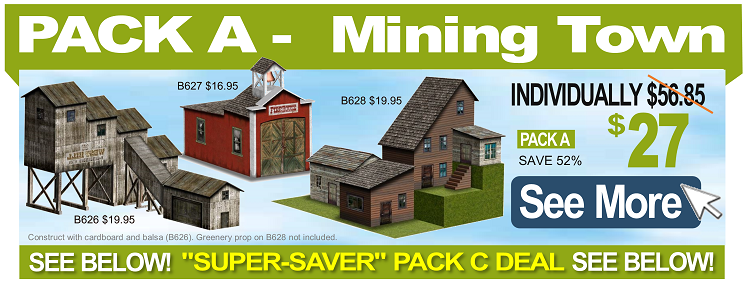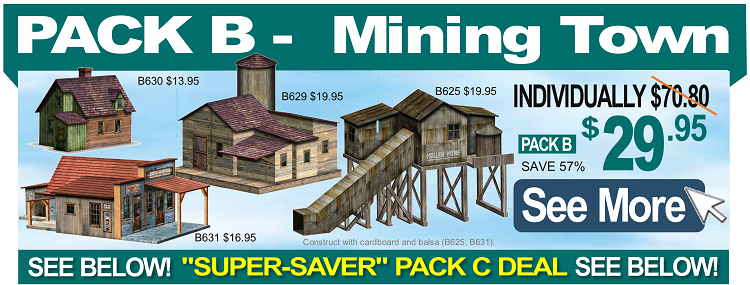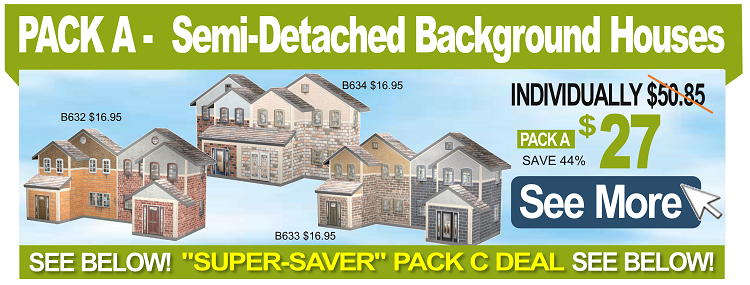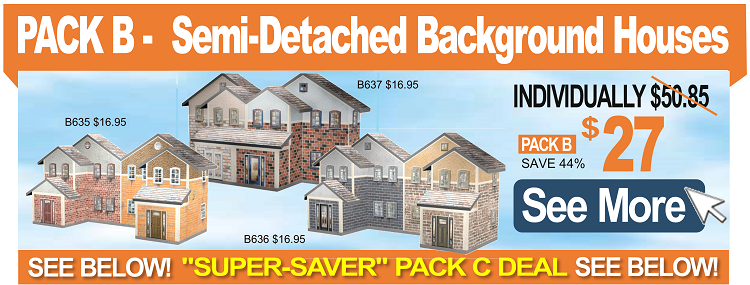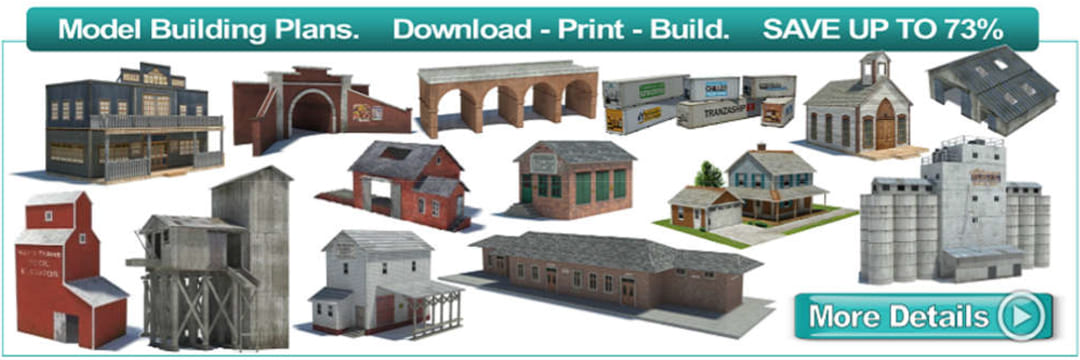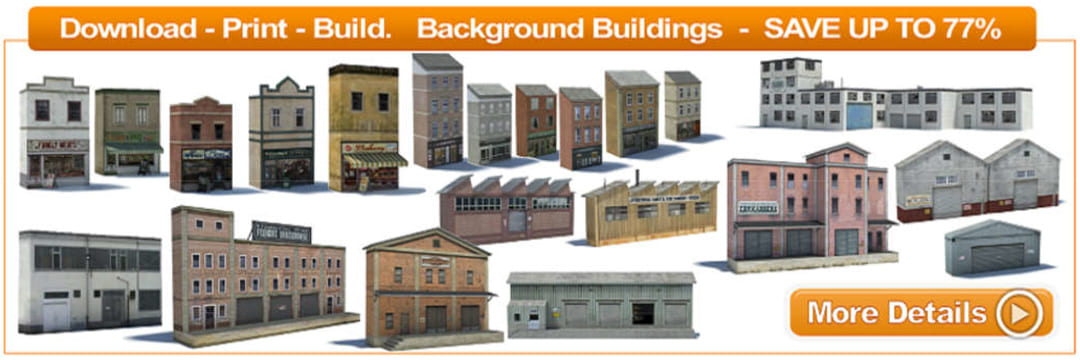200+ “Uniquely Designed” Scale Model Buildings
to Download, Print-Out, and Build, for Model Railroads.
Plans for these 200+ Scale Model Buildings Have
Unparalleled Originality and Realism
If you are fortunate enough to have your very own model railroad either under construction or partly completed, these you’ll probably be interested in trying out some of these miniature scaled replicas of full sized structures. If you don’t own a model railroad, then you might be interested in constructing some of these scale model buildings sold here as a craft project, or as a focal point for a diorama scene. These miniature replicas are also ideal for children completing school projects. Either way, they are enormous fun to build as a pleasurable leisure activity, and it’s very rewarding to stand back and admired the completed structures you personally created.
The printable plans for sale on this website can be easily downloaded and printed out for N scale railroads, or for HO scale or OO gauge railways. The plans can be stuck onto cardboard (old muesli box will be ideal), or in case of backdrop buildings that will rest against the background of your model train layout, use an inexpensive sheet of corflute or foamboard. Both materials can be purchased in big sheets for a very cheap price from DIY, Discount, and Art Supply Stores. Position the constructed scale model buildings around and amongst the scenery on your train layout for maximum effect. You’ll be amazed at the compliments you get from visitors who will undoubtedly be impressed with the preciseness and authenticity of the realism seen in these miniature replicas. The structures will resemble bigger real world buildings they will have seen around cities, towns, and in rural and industrial locations. When put into a miniature town or railyard scene with trains operating nearby, these realistic scale model buildings will help complete the story your train layout is telling. The scaled down buildings will look almost real.
Rail modeler get started in the hobby for varied reasons, and for many, creating scenery and scratch building structures is a highlight of their leisure time activity. It is not surprising considering that constructing scenery and model buildings is very creative and visual. Operating and maintaining trains can be enormous fun too, but for different reasons. We are all different and get enjoyment from different things. And, when you think about it, it is just as well we are not all the same… what a boring and predictable life that would be.
Download Plans to Make Scale Model Buildings in 3D or as Background Structures
Space is always limited and in valuable real estate on an OO / HO scale railroad, and even more so on a smaller N scale railroad. That’s where background industries, warehouses, terraced houses and shops can play a part in maximizing wise usage of the available space against the backdrop.
Railroad backdrops when done well can provide the illusion the scenery disappears miles into the distance. This technique can prove very effective and impressive on a railway layout, because it helps set the scene and tell a story in what is normally a very confined space. Effective background scenery and structures can make the railroad appear considerable bigger than in reality it is. It can also make efficient use of space proving more room for additional yard track, or scenery, without adversely affecting the look of the scene. In fact; quite the opposite; good background scenes can greatly add to the quality and reality of a scale model railroad. That’s where scale model buildings of background structures really come into play on a train layout.
When you look through the vast selection of downloaded printable paper plans for sale here, you will see there are numerous options for constructing backdrop scenery with plans depicting: warehouses, factories, freight deports, large industries, storage facilities, loading docks, terraced houses, city shops and apartments, one and two level residential houses, and many other structures too. Some buildings can even be easily adapted and extended by printing out additional copies. There is not extra download charge if you decide to make an extra building, or print out an extra copy of the plan so as to extend the length of the model. You download once, and can print it out several times if you so choose (personal use only). It is not like buying plastic kits where you would need to pay money to purchase an additional kit, So, as you can appreciate these plan downloads are very reasonably priced, versatile, incredibly realistic in appearance, and super strong and durable after construction is complete and the glue has dried.
Download and Construct Bridges, Walls, Tunnel Portals, and Scale Model Buildings
Apart from the huge range of model buildings for sale, there is also a very interesting series of plans for making arched railway bridges, brick walls, tunnel portals, a freeway flyover, and a pedestrian overpass for miniature plastic people to cross over the railway tracks to an from a railway station.
Planning Space Allocations on Model Railroads
Most modelers begin doodling track plans long before they figure out where to put them. In fact, nearly everyone will create a fabulous track plan and THEN try to find a place to put it. Unfortunately, reality then strikes and the plans are scaled back to a more manageable level.
In any case, there are a number of ways to go about layout planning and design. Most common is to search the internet or acquire one or more books of sample track plans. There are literally hundreds of designs that have appeared over the years and it should be easy to find one of interest that can serve as a starting point for your own variation.
Before buying any track it is important to take a close look at your proposed model train layout space. It always seems to be that the space is never big enough for what you have in mind. It’s a matter of focus. Your story is the focus of the railroad, and how much of what goes on around the subject of the story depends on how much space you have and how you use it. This is where they style and number of scale model buildings you are intending to include on your model railroad layout pays an important part. Even though you have a larger HO scale layout, as opposed to a smaller N scale layout, everything will be to scale so the same number of buildings will be required.
[expander_maker id=”1″ more=”Load more” less=”Load less”]
Telling the story in your layout isn’t the only consideration. Not all of the space you have will be usable for track and scenery. You have to also consider human factors. How high off the floor will the layout be? Does it require aisles to get around and work on it? Will it include topography modeling that will rise high above or dive below grade? Will you be the sole operator, or will there be several people running trains? Do you plan to have many visitors?
There are also several different styles of layouts to consider. An island or peninsula layout will allow access on several or all sides. On the other hand, a shelf style layout can fit comfortably in a rather narrow space along one or more walls. Some styles of layouts lend themselves to certain track arrangements. Shelf layouts in particular are suitable for end-to-end operation without reversing loops of track for continuous running. If a reversing loop is required, a shelf layout will have to have a dog bone section at one or both ends to accommodate the curve radius. Island and peninsula layouts are more suitable for reversing loops and continuous running, but they protrude into the available space.
Scale Model Buildings Positioned on Modular Railroad Layouts
nother interesting arrangement for portability is the modular layout. Modules are created in small standard size units that can be linked together to form huge track runs. Many clubs are oriented around this modeling technique. For a modeler who has severely limited space, this is also a means to enjoy the hobby without a permanent layout.
The beauty of a modular train layout is that it can be dismantled and moved, if you are relocating house… and that can be a big advantage. It can save you from having to build a new layout over again. This is especially helpful if you rent a home, or move locations frequently…which a lot of people do.
Modular train layouts are a great idea, but it is important to remember that the modules will need to be separated at times, so the track joins, scenery and scale model buildings will all be a consideration when it comes to placement.
A modular train layout has many advantages over a fixed layout. The railroad layout can be easily dismantled for displays at train shows, shopping malls and hobby conventions. A modular railway system can exhibited to the public, for people who would otherwise never see model trains operating. Most fixed layouts are generally only seen by a few invited guests, who get to visit the home, or an open day at the local model train club. It is usually a good idea to complete the construction of one module before starting on the next. Now some more things to consider…
Aisles around the model train layout are important. Visitors appreciate a wide aisle that will let them get comfortably close to the trains and scenery (except for toddlers’ hands!). If you have to work on something on the back of the railroad, you will appreciate wide aisles even more. On multiple operator layouts wide aisles are an absolute necessity. 36” is a minimum. 42” is even better.
Layout height is every bit as important as aisle space. This is always a trade-off between the perspective from which you want to view the trains, and the amount of reach you need to be able to conveniently work on the farthest spaces of the railroad layout. There is really no ‘ideal’ height, but 40” to 52” is common. Most people have a reach of about two feet with the layout between waist and chest height. Placing railroad scenery that needs attention or track that might require re-railing a train beyond that reach is bound to be frustrating. If you can visit a train show, take a tape measure with you and check the height of the display layouts. Also, making the scale model buildings to the correct size and consistent proportion in relation to the model trains, plastic people figurines, vehicles, bridges, walls, tunnel portals and other scenery and structures is very important. Although in saying that, it is sometimes possible to position HO scale buildings in the foreground on an HO scale railroad, but have some smaller (possibly as small as N scale) scale model buildings against the backdrop or somewhere in the background. Utilizing smaller buildings in the background can look as if they are far back in the distance. Downloading plans for paper models is the way to go if you want to achieve this effect, because they can easily be scaled in size on a printer. And, if you get anything wrong, you can simply print out another copy. Imagine having to buy a new plastic kit if you made a mistake – that could prove very expensive.
Rail Weights and Codes Explained
While on the subject of model trains and railroads lets talk about something many beginners to the hobby struggle with.
On a real railroad, the actual rails are rated by their weight per yard, which loosely translates to how the rail is to be used. Heavier rails will be used on high speed main line areas, where a lighter rail will often be used in a lower speed or less heavily traveled siding or yard area. Real rails typically have a rail profile height somewhere between slightly under five and slightly over seven inches, depending on the railroad and the standard that it uses. If we were to model the exact rail profile in N scale, the height of each rail should be between about .031 and .043 inches.
There’s no ‘weight’ measurement in model railroading, but there is a ‘code’ description. The code of the rail refers to the actual rail height in thousandths of an inch above the tie. In N gauge track, you will see Code 40, 55, 65, 70 and 80 which correspond to .040, .055, .065, .070, and .080 inches tall. You can see that the only rail code that matches actual real world railroads would be code 40. However, this poses a problem that is not unique to N scale modeling.
It’s important in both real railroading and modeling for the trains to remain on the tracks. Modern prototypical railroad cars have wheels that have a rim, or flange that holds the wheel on the rails. Modern cars are also heavy, and the combination of the flange and the weight of the car generally keeps the car on the track. In modeling, the wheel sets also have a flange, but the weight of the car is not proportional to the weight of the real thing. To compensate and keep our small trains on the tracks, the flanges on the wheels are much larger than scale. This is where the rail height comes into play. A code 40 or 55 rail may cause the flanges on some cars, particularly older ones, to ride up over the ties as the car moves, promoting rather than reducing derailment.
There are replacement trucks and wheel sets available for most rolling stock, but the wheels of locomotives are not generally easily replaced. Some modelers have reported success in machining their locomotive flanges to a smaller diameter, but this is a very advanced modeling technique that also requires specials tools and skills. A much easier solution is to use a larger code rail and try to divert the viewer’s attention from the inaccurate proportion.
Code 55 and code 80 rails are commonly seen layout standards. Both come in fixed rail and flextrack products. Manufacturers such as Peco, Shinohara, Atlas, and Micro-Engineering provide a complete range of products for mainline track as well as turnouts, crossovers, and other special arrangements.
It is possible to mix manufacturers on a layout, but careful attention has to be paid to the transition between different types and codes of track. At the very least, some shimming will be required to match the railheads precisely enough to prevent derailing. Mixing products is not a good idea for the beginner, however, and it would be wise for you to build a layout or two with homogeneous products before trying to mix and match.
Like other scales, it is possible to hand lay N scale track. If you are a beginner to model railroading, or have poor eyesight and hand-eye coordination, hand laying may not be for you. If it seems attractive, try creating a small diorama with hand laid track before committing to a substantial layout project. There are tools and jigs available from most model railroading hobby suppliers that will help the process, but it is work intensive to say the least. The up side is that it can be marvelously realistic if done well!
I hope you have found this information valuable in assisting you in the construction and efficient operation of your model railroad layout. And, hopefully you do have a go at construction your own scenery and scale model buildings. The printable plans for sale here can be downloaded and put together with the aid of some adhesive, cardboard, corflute (for background structures), and possibly some balsa wood for making decking and posts. We are not one of the big players that dominate the model railroading industry, so every sale counts and we will very much appreciate your support. In turn we do our best to support the model railroading community where we can. Please download some of these scale model building plans and judge for yourself how good they are on your train layout. Download, print, and build. It’s a lot of fun and surprisingly easy.
[/expander_maker]

